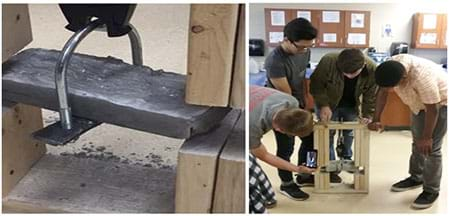Materials List:
Shantytown Construction Redesign
 https://www.teachengineering.org/activities/view/uod-1921-shantytown-construction-redesign-composite-material-science
https://www.teachengineering.org/activities/view/uod-1921-shantytown-construction-redesign-composite-material-science
For the teacher’s introductory presentation:
- laptop/tablet, internet access, word processing access, presentation access (e.g., Google Slides, PowerPoint, Prezi)
Note: The following is for a class of 30 working in groups of three students each.
Each group needs:
- 3 pairs of gloves
- 3 Rubbermaid or Sterilite ice cube bins, such as at Walmart
- 3-4 paint sticks, such as a 10-pack at Home Depot (or for free from most stores that sell paint if you say it is for a school project)
- 1 small bucket (3 gallons or less) from hardware store or Amazon
- 3 dust masks, such as packs of 50 from Amazon
- Making Concrete Blocks Lab sheet
For the entire class to share:
For making concrete blocks
- recycled, reused or discarded items; have students bring from home (ideally, collect materials that fall under one of three categories: metals, ceramics, polymers, or composites)
- 10-12 pairs of scissors
- 1-2 hammers
- lab scale or lab balance
- (optional but highly recommended) plastic wrap and masking or painter's tape to protect the balances
- (optional but highly recommended) large tarps and painter's tape to protect the lab area; 6 x 8-foot blue, multipurpose, waterproof Grizzly Tarps work well, from Amazon.
- 2 bags of Sakrete: 94-lb Portland Cement Type I/II Commercial Grade Quickrete, available at hardware stores like Lowe's or Home Depot
- buckets for cement mixing
- cups for scooping out and weighing cement; such as 8 oz. Styrofoam cups
- 6-8 gallons of water (tap water is okay)
- (optional) 1 premade sample to serve as example
For chemical testing
- 3 pairs of goggles
- 1-12 medium test tubes, large test tubes, small beakers or small cups
- Materials for labeling test tubes and beakers
- up to 12 pipettes
- up to 12 small samples of the chosen substrate
- Chemical Testing Lab sheet, 1 per group
- up to 12 beakers/cups for putting classroom samples into
- 10 ml of the following samples:
- bleach
- vinegar
- oil
- dirty/polluted water
- dirty/polluted salt water
- dish soap
- laundry soap
- hydrochloric acid (HCl)
- sodium hydroxide (lye) (NaOH)
- acetone (CH3)2CO (paint thinner or nail polish remover)
- household drain cleaner
For physical testing
- small crane scale, available at Amazon
- gallon heavy-duty Ziploc bags for drop test
- block crushing machine (see image below); have students make this simple machine possibly with the assistance of an industrial arts or wood shop class; see build instructions on the Block Crusher Design Instructions
- (optional) a few extra bolts for the block crusher; for sizing, refer to the Block Crusher Design Instructions extra individual assignments for students to work on while testing is occurring; see the Extra Individual Assignments
- (optional) a premade sample concrete block to use as a control; follow the Making Concrete Blocks Lab to build the block

Reuse most of the items from the Making Concrete Blocks Lab, but may need additional items such as:
- additional recycled, reused or discarded items that students bring from home (ideally, have the materials fall under one of three categories: metals, ceramics, polymers, or composites)
- 1 pair of gloves per person
- 1 bag Sakrete: 94-lb Portland Cement Type I/II Commercial Grade Quickrete, available at hardware stores like Lowe's or Home Depot
- 3 gallons of water
 https://www.teachengineering.org/activities/view/uod-1921-shantytown-construction-redesign-composite-material-science
https://www.teachengineering.org/activities/view/uod-1921-shantytown-construction-redesign-composite-material-science